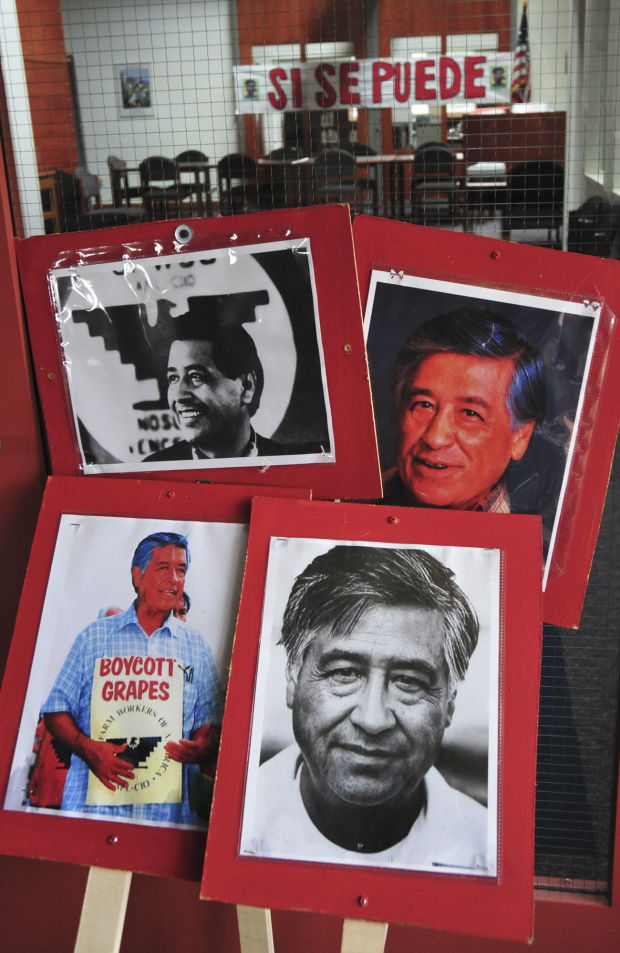Cesar Chavez to be inducted to Vintners Hall of Fame
Vintage signs and photos of Cesar Chavez were displayed in St. Helena during a celebration of the labor organizer’s birthday in March 2012.
Vintners Hall of Fame Induction Celebration
• Culinary Institute of America at Greystone, 2555 Main St., St. Helena
• Inductees: Cesar Chavez, labor leader; Meredith “Merry” Edwards, winemaking pioneer; Robert Parker, founder, The Wine Advocate; Frank Schoonmaker, wine writer
Now in its seventh year, the Vintners Hall of Fame, at the Culinary Institute of America’s Greystone campus in St. Helena, has done a fine job of recognizing the accomplishments of many individuals who have significantly contributed to the California wine industry, 40 to date.
It’s a mix of those living and passed-on, and include renowned names in winemaking, research and industry pioneers with a peppering of wine journalists and influential trade. Interestingly, none to date have been Hispanic nor representing field workers, but with 2013’s class of inductees, that is about to change with the honoring of one of its most controversial to date, Cesar Chavez.
Whether one agrees with unionization of farm workers — or any work force — or not, the mark on agriculture and the wine industry by Chavez has been significant. He passed away in 1993. People today often have vague ideas of his accomplishments to protect farm workers.
He was born outside of Yuma, Ariz. on March 31, 1927. His family owned a grocery store and a ranch, but lost both during the Great Depression forcing his family to become migrant farm laborers in California. In World War II he hoped to improve his lot by joining the Navy, but there were limited opportunities for Mexican-Americans so he returned to the fields. As a community organizer in 1962 he began the National Farm Workers Association which would become the United Farm Workers of America (UFW). The UFW’s motto to this day “Si Se Puede,” Spanish for “Yes, it is possible.”
He was very protective of American workers’ rights; an idea often lost in history, and opposed the Bracero program that brought immigrant workers from Mexico to U.S. fields staring in 1942. He was instrumental in terminating that program in 1964 because he believed it exploited immigrants and denied Americans work.
Chavez organized farm labor with the firm-held belief in non-violent demonstration. He helped Filipino-American farm workers in Delano (Kern County) organize what would be a five-year strike encouraging a grape boycott that would lead to the historic march to California’s state capitol, more than 300 miles, in 1966. He was applauded for his work at the time by U.S. Senator Robert F. Kennedy.
In the early 1970s came the Salad Bowl strike specifically targeting grapes and lettuce. The chant of “boycott lettuce, boycott grapes . . . ” was a national cry for solidarity and was wildly unpopular in the wine industry of the day.
Napa Valley’s mantra is that all great wine begins in the vineyard and farm workers are the powerhouse that makes these world-class vineyards thrive. For decades, here and across the California wine industry, Cesar Chavez was their acknowledged leader. With his work through the UFW, vintners industry-wide have realized the importance of farmworkers’ contribution to the world of wine.
In Napa Valley the wine industry has changed, evolved and is arguably the crown jewel of American agriculture. One is hard-pressed to find significant populations of migrant farm labor in the valley these days. Growers who once counted three passes in the vineyard — to prune, sucker and pick, are now counting more than 20 passes vine to vine requiring year-round work in the vineyards. That’s true in Napa Valley where four tons to the acre is the appellation’s average, but is a far cry from the 12 or 15 tons, or more per acre being harvested in the Central Valley.
Chavez’s leadership in helping pass the California Agricultural Labor Relations act, among many other accomplishments finally gave a voice to this sector of the wine industry where today they are recognized as highly skilled and integral to the industry. Their voices are now increasingly those of Latino winery owners, managers and industry leaders.
Chavez’s legacy is still unfolding, albeit posthumously. Soon after his death, in 1994, President Clinton awarded him the Presidential Medal of Freedom. He has been honored with a U.S. postal stamp, his portrait hangs in the National Portrait Gallery in Washington, D.C., a U.S. Navy cargo ship has been named in his honor along with countless schools, student centers, public plazas, streets and highway across the U.S. Governor Schwarzenegger inducted him into the California Hall of Fame, and a high school in Delano, Calif., where the movement began, is named in his honor.
Chavez’s birthday, March 31 is recognized as a state holiday in California, Colorado and Texas and the date is honored nationally as “Cesar Chavez Day.” This past October President Obama designated his home and surrounding property in the Tehachapi Mountains of Kern County where he is buried, as America’s latest national monument. The recognition by the Culinary Institute of America is time.
(Terry Hall is the founder of a communications, branding and event planning business in St. Helena and was formerly the communications director of the Napa Valley Vintners.)

